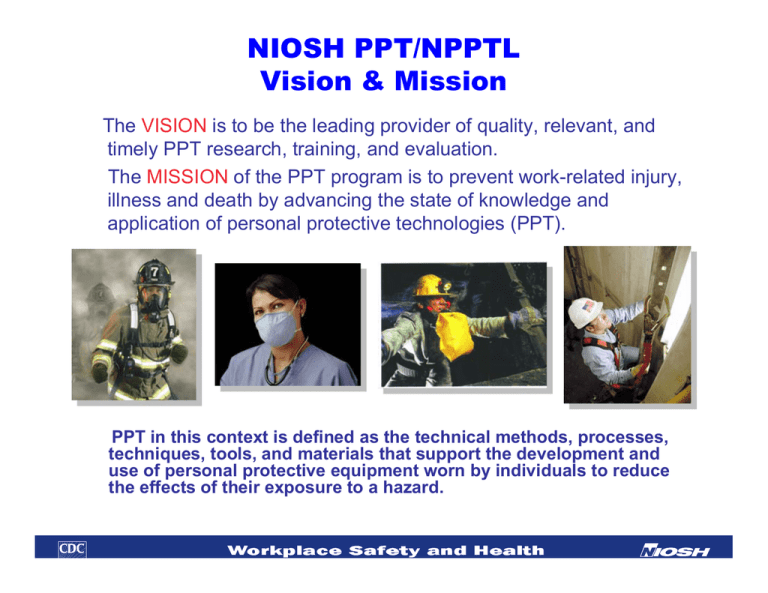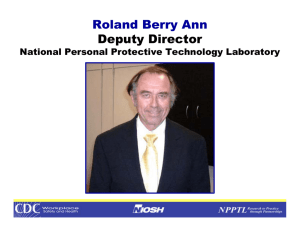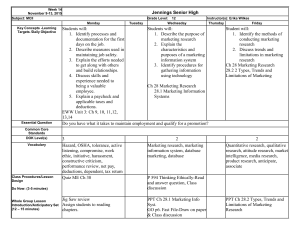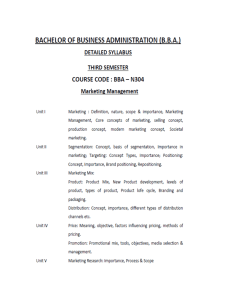NIOSH PPT/NPPTL Vision & Mission
advertisement

NIOSH PPT/NPPTL Vision & Mission The VISION is to be the leading provider of quality, relevant, and timely PPT research, training, and evaluation. The MISSION of the PPT program is to prevent work-related injury, illness and death by advancing the state of knowledge and application of personal protective technologies (PPT). PPT in this context is defined as the technical methods, processes, techniques, tools, and materials that support the development and use of personal protective equipment worn by individuals to reduce the effects of their exposure to a hazard. National Institute for Occupational Safety and Health (NIOSH) Personal Protective Technology Program (PPT) Welcome & Meeting Overview Les Boord Director NPPTL Pittsburgh, PA 15236 March 6, 2008 Stakeholder Meeting Objective To facilitate stakeholder communications by: ¾Sharing project information ¾Encouraging information exchange ¾Obtaining program comment ¾Requesting program evaluation (Customer Satisfaction Survey) Meeting Format ¾NIOSH PPT Program Presentations ¾NIOSH PPT Program Posters ¾Stakeholder Comment Station ¾PPT Program Customer Satisfaction Survey Station Meeting Agenda 7:45 – 8:30 a.m. Registration 8:30 – 9:00 a.m. Welcome and Opening Remarks 9:00 – 9:45 a.m. PPT Presentations - Reduce Exposure to Injury Hazards 9:45 – 10:30 a.m. PPT Presentations – Reduce Exposure to Dermal Hazards 10:30 – 10:45 a.m. Break 10:45 – 12:00 p.m. Science Strategy/Action Plans 12:00 – 1:30 p.m. Lunch/Poster Sessions 1:30 – 2:30 p.m. PPT Presentations – Reduce Exposure to Inhalation Hazards 2:30 – 3:30 p.m. Poster Session 3:30 – 4:00 p.m. PPT Program Strategy/Office of Extramural Programs 4:00 – 5:00 p.m. Wrap-Up/Poster Session NIOSH Office of the Director Dr. Lew Wade Agency Hierarchy HHS Department of Health and Human Services CDC Centers for Disease Control and Prevention NIOSH National Institute for Occupational Safety and Health Div/Labs NIOSH Divisions / Labs NIOSH Divisions & Laboratories • Division of Respiratory Disease Studies (DRDS) • Division of Safety Research (DSR) • Health Effects Laboratory Division (HELD) • Education and Information Division (EID) • Office of the Director, NIOSH • Office of Extramural Programs • Pittsburgh Research Laboratory (PRL) • National Personal Protective Technology Laboratory (NPPTL) • Division of Applied Research and Technology (DART) • Division of Surveillance Hazard Evaluation and Field Studies (DSHEFS) • Office of Compensation Analysis and Support (OCAS) • Research to Practice (r2p) • Spokane Research Laboratory NIOSH Program Portfolio Industry Sectors (N=8) • Agriculture, forestry, and fishing • Construction • Healthcare and social assistance • Mining • Manufacturing • Services • Transportation, warehousing, and utilities • Wholesale and retail trade Cross Sector Programs (N=24) • Authoritative recommendations development • Cancer, reproductive, cardiovascular, neurological & renal diseases • Communications and information dissemination • Emergency preparedness/response • Radiation dose deconstruction • Respiratory diseases • Training grants • Traumatic injury • Work organization and stress-related disorders • Economics • Exposure assessment • Global collaborations • Engineering controls • Health hazard evaluation (HHE) • Work life initiative • Hearing loss prevention • Occupational health disparities • Immune, dermal and infectious diseases • Small business assistance and outreach • Musculoskeletal disorders • Surveillance • Personal protective technology • Nanotechnology • Prevention through design NIOSH PPT/NPPTL Vision & Mission The VISION is to be the leading provider of quality, relevant, and timely PPT research, training, and evaluation. The MISSION of the PPT program is to prevent work-related injury, illness and death by advancing the state of knowledge and application of personal protective technologies (PPT). PPT in this context is defined as the technical methods, processes, techniques, tools, and materials that support the development and use of personal protective equipment worn by individuals to reduce the effects of their exposure to a hazard. PPT Program Goals/Objectives/Tactics • Strategic Goal 1 – Reduce Exposure to Inhalation Hazards • Strategic Goal 2 – Reduce Exposure to Dermal Hazards • Strategic Goal 3 – Reduce Exposure to Injury Hazards • Intermediate Objectives - Goal 1 → 8 Objectives - Goal 2 → 3 Objectives - Goal 3 → 8 Objectives • Tactics – – – – Comprehensive research PPT standards development Respirator certification and PPT evaluation activities r2p → communications & outreach PPT Program Activities PPT PPT Program Program Management Management Technology Technology Evaluation Evaluation Policy Policy & & Standards Standards Development Development Technology Technology Research Research PPT Program Activities vs S.G. Goals Workplace Needs Achieving Performance Excellence (APEX) • Initiative for Continuous Improvement • Malcolm Baldrige Criteria – 7 Categories – Leadership – Strategic Planning – Customer / Market Focus – Measurement / Analysis / Knowledge Mgmt – Human Resource Focus – Process Management – Business Result Quality Performance Initiatives ADS: Maryann D’Alessandro • Evaluations – National Academies involvement in NPPTL – Scientific information product review – Benchmarking • Customer and Market Knowledge – – – – Standards Development Committee Involvement PPT Surveillance Public meetings and feedback Customer Satisfaction Groups (Focus Groups) • Customer Relationships and Satisfaction – Customer Satisfaction Surveys (CSS) – Direct Customer involvement Academia - SDOs - Government Laboratories – Unions – Labor - Manufacturers Strategic Value Creation System Inputs NPPTL Programs / Activities Outputs Intermediate Outcomes Public Benefit Outcomes Performance Measures Program Execution Components Technology Developers / Providers User Communities Other Stakeholders / Regulators / Congress / Administration / State Organizations Surveillance and Environmental Assessment National Academies COPPE PPT Program Annual Strategic Planning Process Meeting Agenda 7;45 – 8:30 a.m. 8:30 – 9:00 a.m. 9:00 – 9:45 a.m. Registration Welcome and Opening Remarks PPT Presentations - Reduce Exposure to Injury Hazards Warning Devices for Fire Service Fall Protection Hearing Protection 9:45 – 10:30 a.m. PPT Presentations – Reduce Exposure to Dermal Hazards Chemical Dermal Hazards Emergency Responders Protective Clothing Physiological and Ergonomic Impact 10:30 – 10:45 a.m. 10:45 – 12:00 p.m. Break Science Strategy/Action Plans PPT Evaluations PPT Surveillance Healthcare PPE /Pandemic Preparedness Anthropometrics and Fit Research 12:00 – 1:30 p.m. 1:30 – 2:30 p.m. Lunch/Poster Sessions PPT Presentations – Reduce Exposure to Inhalation Hazards Respirator Certification Mine Escape Respirators Standards Development Activities CBRN Guidance Documents Respiratory Protection Research 2:30 – 3:30 p.m. 3:30 – 4:00 p.m. 4:00 – 5:00 p.m. Poster Session PPT Program Strategy/Office of Extramural Programs Wrap-Up/Poster Session PPT Presentations Reduce Exposure to Injury Hazards Roland Berry Ann NIOSH PPT/NPPTL Vision & Mission The VISION is to be the leading provider of quality, relevant, and timely PPT research, training, and evaluation. The MISSION of the PPT program is to prevent work-related injury, illness and death by advancing the state of knowledge and application of personal protective technologies (PPT). PPT in this context is defined as the technical methods, processes, techniques, tools, and materials that support the development and use of personal protective equipment worn by individuals to reduce the effects of their exposure to a hazard. FY’09 PPT Program Strategic Planning Les Boord PPT Program Annual Strategic Planning Process PPT Strategic Planning Process • Stakeholder meeting March 6, 2008 • Mid-year review of active projects (internal) – April 8,9 & 10 – Report on status & projection • Annual Summit Meeting – Environmental assessment • COPPE • Evaluations • OPM Survey • Stakeholder meeting • Other – Information from mid-year review reports • Resource allocations Program Resource Allocation Guidelines − Evaluations (Cost of Quality 3% to 8% Norm) : • NAS → COPPE, Project Reviews • OPM → Organizational Assessment Survey • Other Reviews → Peer Review Activities – r2p (3% to 5% of base budget) : • Outreach → Conferences, Workshops … • Standards Development Activities → SDOs • Stakeholder Meeting → Today − Respirator Certification • Audit & Continuing Programs PPT Program Production Input Funding Distribution (in Millions of $) $20.00 $18.00 $10.00 $0.17 $1.32 $2.83 $3.62 $8.85 $5.58 $1.85 $12.00 $11.87 FY03 $11.79 FY02 $12.26 $8.59 FY01 FY05 FY06 FY07 FY08 $11.25 $9.12 $6.00 $4.00 $12.20 $8.00 $8.62 $ in Milions $14.00 $3.93 $16.00 $2.00 $0.00 FY04 Fiscal Year NPPTL Direct Base Allocation Outside Funding Sources Total Funding Allocation FY01 -FY08 = $113.83 Million NPPTL Discretionary Funding (in Millions of $) $14.00 $12.26 $12.20 $12.00 $11.87 $11.25 $10.00 $ in Millions $11.79 $9.12 $8.62 $8.59 $8.00 $6.00 $4.00 $6.75 $6.72 $4.74 $2.00 $6.47 $5.64 $4.64 $5.19 $6.05 $0.00 FY01 FY02 FY03 FY04 FY05 FY06 Fiscal Year NPPTL Direct Base Allocation Discretionary Funds FY07 FY08 Meeting Format ¾NIOSH PPT Program Presentations ¾NIOSH PPT Program Posters ¾Stakeholder Comment Station ¾PPT Program Customer Satisfaction Survey Station Stakeholder Meeting Objective To facilitate stakeholder communications by: ¾Sharing project information ¾Encouraging information exchange ¾Obtaining program comment ¾Requesting program evaluation (Customer Satisfaction Survey) YOUR participation is important to the PPT Program strategic planning ¾Visit Project Posters ¾Provide Program Comment ¾Complete Customer Satisfaction Survey ¾Complete Stakeholder Meeting Evaluation Form NIOSH NPPTL/PPT Program Visit Us at: http//www.cdc.gov/niosh/npptl/default.html Disclaimer: The findings and conclusions in this presentation have not been formally disseminated by the National Institute for Occupational Safety and Health and should not be construed to represent any agency determination or policy. Thank you




